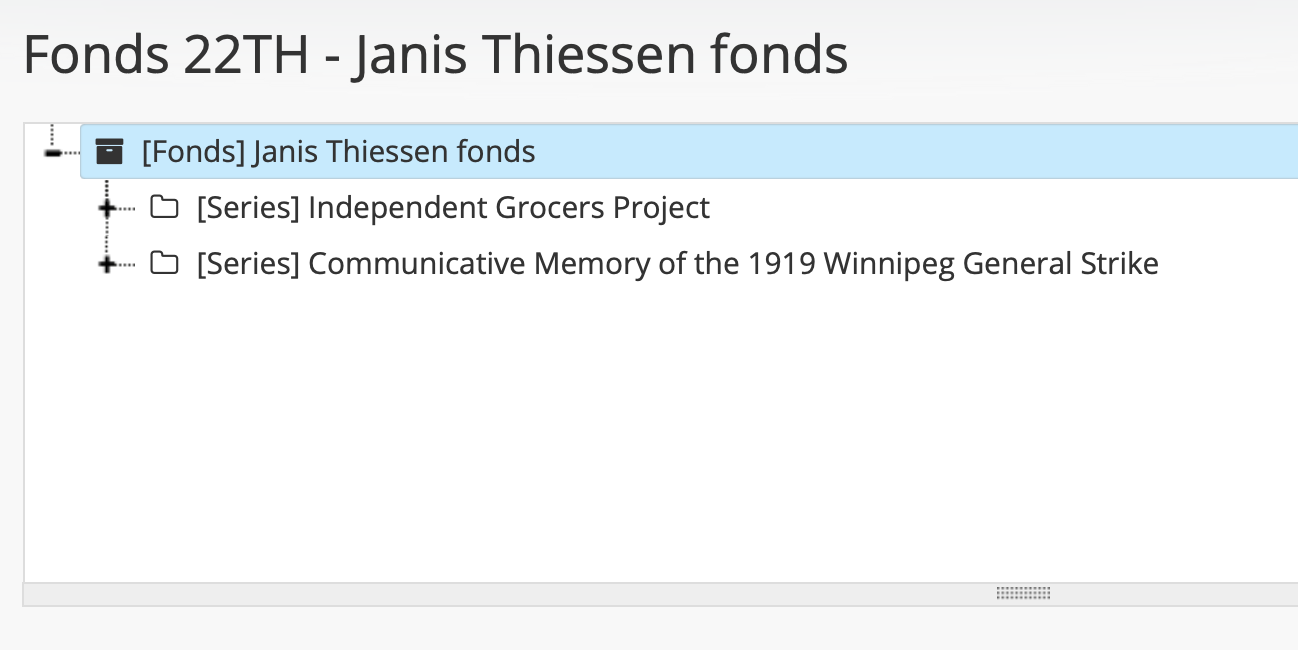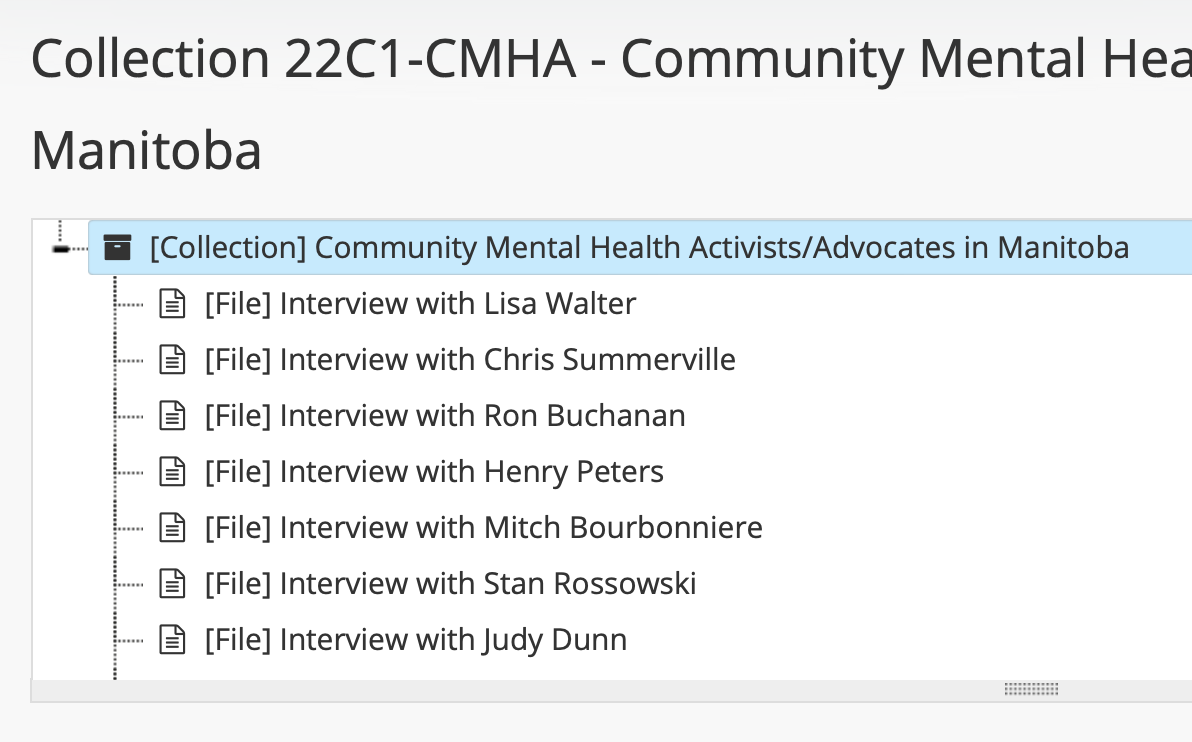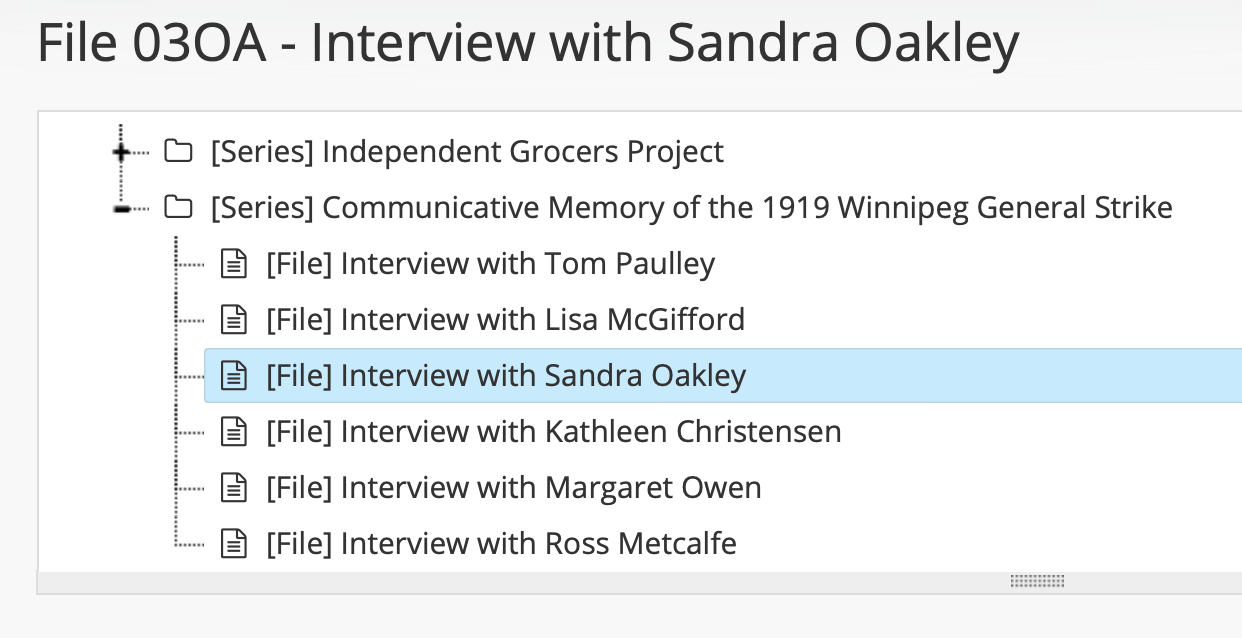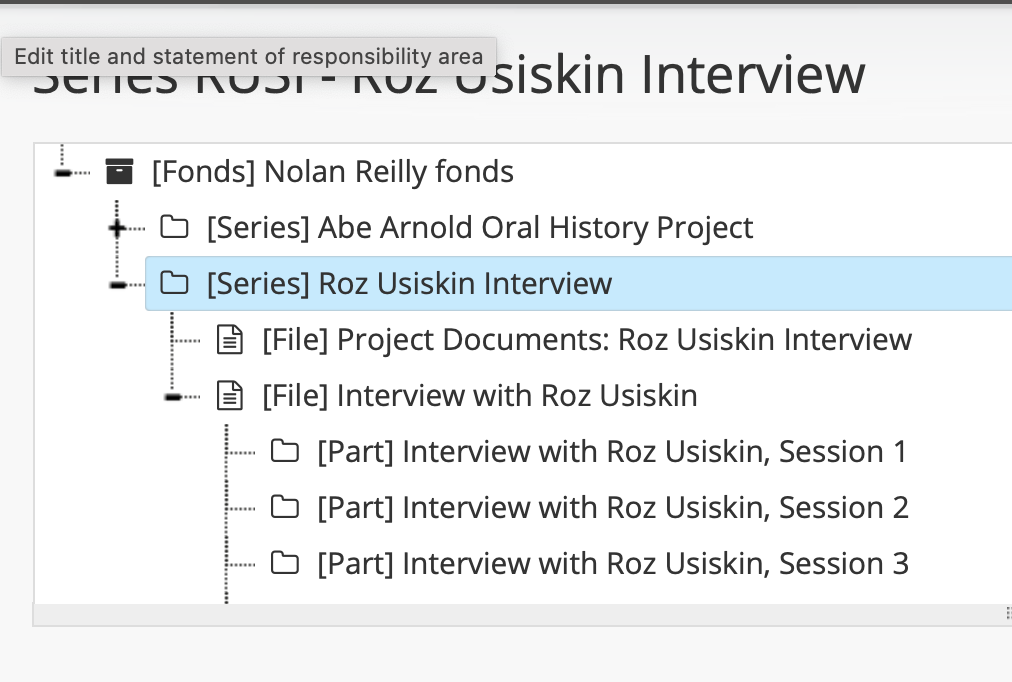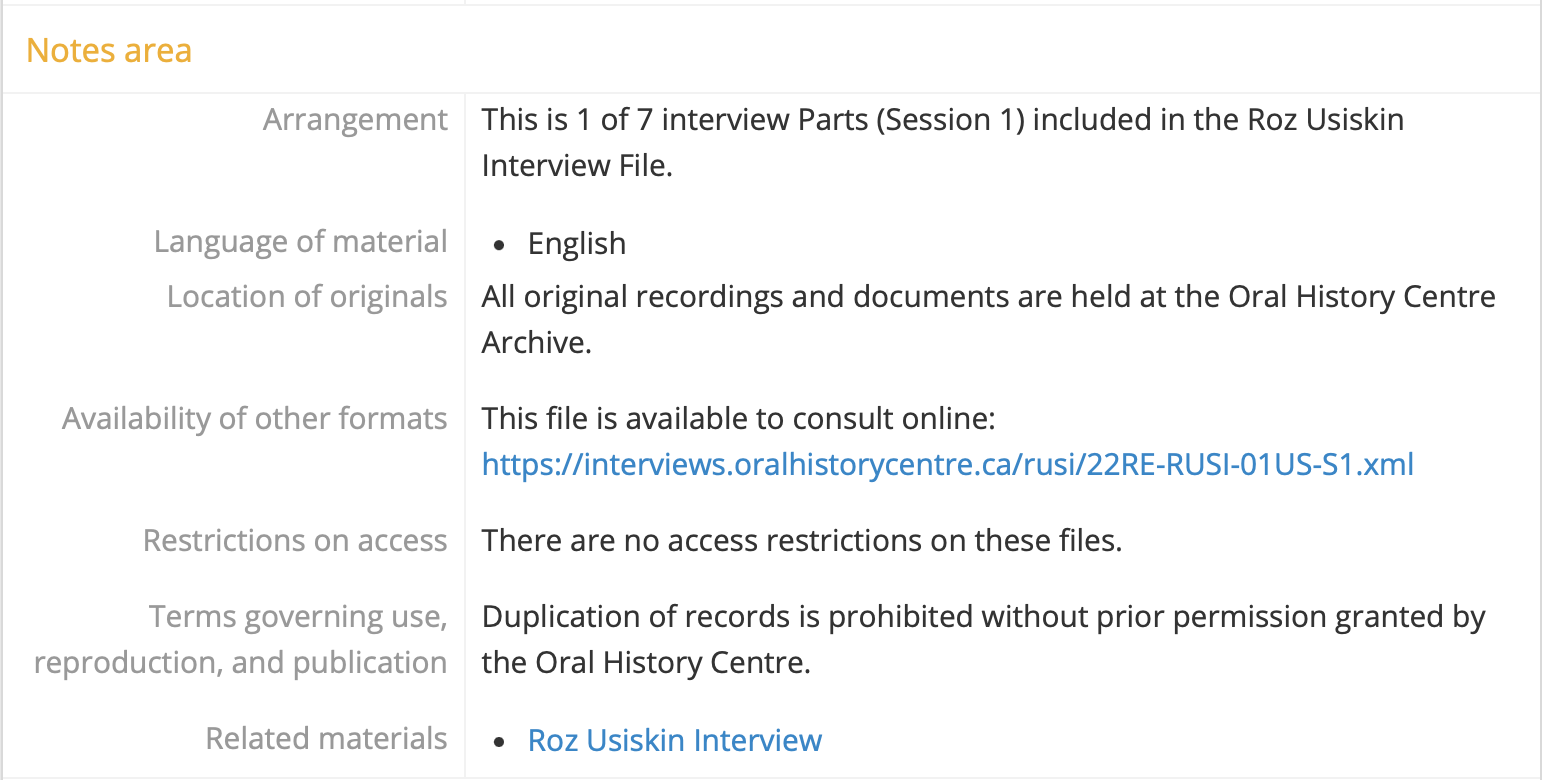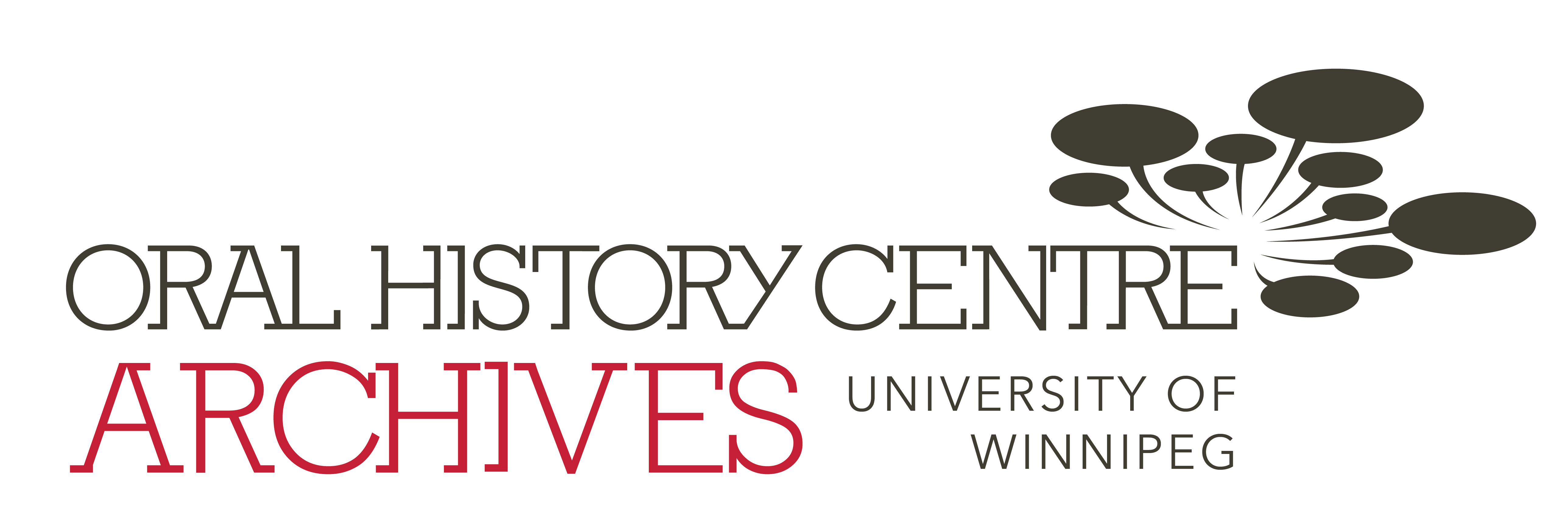
Search the Catalogue
Alphabetical Listing
Navigating the Archives
About The Archives
Contact Us
The OHC archive is a work in process. It will inevitably change as it grows, and we work through processing existing collections, and acquire new ones. It will shape over time as we make our collections discoverable and accessible, expand the glossary of terms, and add new imagery. Our goals in creating this website are:
-
- To create an online archives environment that is equally accessible to academic researchers and community members.
- To make each oral history interview preserved at the OHC Archives discoverable, always within the context of its creation.
- To be transparent in how we have arranged and processed collections.
- To facilitate online access to interviews where appropriate, and facilitate other modes of access where it is not.
Online access to the OHC Archives relies on three distinct components that are linked together: The OHC Website, The OHC Archives Catalogue, and the Oral History Metadata Synchronizer (OHMS). The role of our website is to direct you to our catalogue and create an online environment to engage with interviews. The role of Access to Memory is to make a catalogue of our collections discoverable, and the role of OHMS is to facilitate online access to interviews.
Although each interview that is accessible online is linked to our online catalogue, and the OMHS interface directly links the interview index and transcript to the media, it is currently only possible to search across the catalogue descriptions, or to search more specifically within a single interview session.
This means that in our archive, we are missing a bridge between the ability to search catalogue descriptions and the ability to search within each interview across collections—in other words, to search within all interviews at once, and the ability to sort and filter those search results. The next phase of development for our archive includes exploring opportunities to implement a database that can facilitate this.
The “OHC Archives” website is a distinct section of the Oral History Centre’s main website, which is self-hosted WordPress site. For ease of navigation, the OHC Archives landing page, and each of the 5 sections linked in the bold sub-menu are fashioned to be aesthetically distinct in order provide clarity as to when you are in the OHC Archives and when you have navigated away, for example, to search our catalogue. The infrastructure of our website also supports access to interview using the Oral History Metadata Synchronizer (OHMS).
Our archival catalogue uses Access to Memory (AtoM), a web-based, open source platform for archival description. Our Catalogue appears as a repository within the province-wide Manitoba Archival Information Network (MAIN), hosted by the University of Manitoba Archives.
We chose to use this shared repository for a few reasons: it was the easiest, most cost-effective means of beginning to catalogue our interviews. The great thing about this shared space, is that is positions our collections alongside other archival repositories in the province and creates the possibility of creating connections between interviews in our archives and other archival records in the province.
Choosing “Search the Catalogue” in the menu will cause you to navigate away from our website, but the MAIN database will open in a new window so that you won’t lose your place.
Navigating the Catalogue
The OHC Repository in the MAIN database shows the contents of of our archive in a nested order reflecting the OHC’s preferred mode of arrangement for oral history collections. Much of the time, when we acquire an oral history collection, it is already in this arrangement. But in instances where a grouping of interviews was unorganized, or would have been excessively difficult to navigate, we have created an “access copy” of the series in order to provide online access and facilitate a consistent user experience across our archives.
We preserve all records in their original order. Those that have been reorganized for ease of navigation will state so in the series level description of the catalogue.
Our catalogue begins most broadly at the fonds or collection level, each of which can be expanded to view any sous-fonds, series, subseries, file, and part contained within. Interview sessions within each series or subseries are arranged chronologically, according to the order in which they were conducted.
The aim of this arrangement is to provide item-level descriptions of each interview in our collection, and at the same time, present each within the detailed context of their creation: Individual interviews are presented in the context of project for which each was conducted, and shown alongside all other interviews conducted for that same purpose; each series is then contextualized within a broader sous-fonds, fonds, or collection as appropriate.
The Glossary of Terms below outlines each level of the OHC archive in more detail.
The Oral History Metadata Synchronizer (OHMS) is a web-based platform developed by the Louis B. Nunn Center at the University of Kentucky. In addition to provided online access to interview media, OHMS is capable of displaying metadata such as the date and location of an interview, as well as administrative information such as the terms of use of a particular recording.
OHMS also links interview media (audio/video recording) to both an interview index and the interview transcript. With the added functionality of keyword searching, these functions together provide the ability to search within the interview index and transcript, and to navigate to precise sections of a recording with the click of a button.
Interviews that are publicly accessible via OHMS will have a direct link to the interview in the “Availability of Other Formats” section of the Catalogue listing.
FONDs
fonds are the largest level of organization used in the OHC Archive.
The fond container includes all records generated by, or donated by an individual, or organization. A fond could be named after an individual researcher, or after an organization, business, or community group. Typically, a fond will include more than one series of records that have been added over time, or there will be additional series of oral history records added going forward.
Examples of fonds in the OHC Archive Catalogue:
COLLECTION
Like a fond, the collection container includes all records generated by, or donated by an individual, or organization. However, unlike the fonds, it is a stand-alone project. We do not anticipate that the individual or organization will produce any further series of oral history records. Typically a collection will not contain more than one Series, but there are exceptions.
Examples of collections in the OHC Archive Catalogue:
Examples of collections with more than once series of interviews in the OHC Archive Catalogue:
SERIES
The Series level is used to describe one complete Oral History project. Some series will consist of multiple interviewing phases called Sub-series, some will contain only one series of interviews, and some will only contain one interview in multiple parts (sessions). Usually, the collection is named after the original project title, and will end with the word “Project.”
Examples of series in the OHC Archive Catalogue:
SUB-SERIES
The Sub-Series level is used to identify all phases of interviewing that took place within a single Series. Sub-series are normally found in large oral history projects where the interviewing progressed in distinct phases over time, or within distinct geographic locations.
There are currently no examples of sub-series in the OHC Archive Catalogue. We will update this section with an example when we add one.
FILE
You will find all parts of an interview within a file. This type of file is normally named after the individual or individuals interviewed and included all parts of an interview all recordings, transcripts, and any other materials related to that interview. Files are also used to keep documents related to a particular series of interviews, or to a project as a whole.
Examples of files in the OHC archives include:
PART
Part is used to describe one session of the interview whole. A session normally results from the participants meeting on separate occasions over time to conduct the interview. Generally, each interview session, or part, will have a unique date.
Examples of Parts in the OHC Archive Catalogue:

